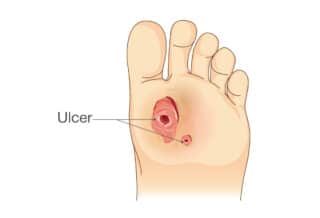
Arlington Podiatry Center
611 South Carlin Springs Road
Suite #512
Arlington, VA 22204

More Podiatry Foot Care Articles
Pressure Ulcers

What Are Pressure Ulcers?
Pressure ulcers are sores that occur when pressure cuts off the blood supply to the skin. The ball of the foot, the big toe, and the heel are at greatest risk. Untreated ulcers may allow infection to enter your body. If infection reaches the bloodstream or bone, your life or limb may be at risk.
How Do Pressure Ulcers Form?
Force or friction against the bottom of your foot causes the skin to thicken, forming a callus. If the skin keeps thickening, the callus presses up into the foot. This kills healthy tissue and causes pain. Unfortunately, you may not notice the pain if you have neuropathy, a health problem that limits how much feeling you have in your feet. As healthy skin dies, an ulcer forms. Ulcers may progress from hot spots to infected wounds very quickly.
Red hot spots on the skin are signs of pressure or friction. Left untreated, a blister can form and turn into an open wound or a corn (thickened skin on top of the foot) or callus.
If a corn or callus presses into the foot, it destroys inner layers of skin and fat. Cracks and sores may form. These open wounds are ulcers. They provide a way for infection to enter the body. In some cases, dead skin (such as a corn or callus) may cover an open wound, making it harder to see.
If bacteria enter the ulcer, infection sets in and may begin to drain white, yellow, or greenish discharge. Some infected ulcers bleed or have a bad odor. If you develop an infected ulcer, call your doctor right away.
Your Physical Exam
Hot spots, small cracks, or sores can be treated before they get infected. Blood flow and nerve sensation in your feet may be tested if you have a chronic health problem, such as diabetes. A deep pressure ulcer may require an x-ray.
To take pressure off hot spots and ulcers, your doctor may prescribe orthotics. To control or prevent infection, your doctor may prescribe antibiotics. Surgery may be needed if infection enters deep tissues or bone.
Preventing Ulcers
To prevent ulcers use a mirror to look at the bottom of your feet each day. By doing so, you can catch small skin changes before they turn into ulcers.
Call your doctor if you notice hot spots, red streaks, swelling, or any cracks or sores. Also, check the soles and insides of your shoes before putting them on and remove any objects.

















